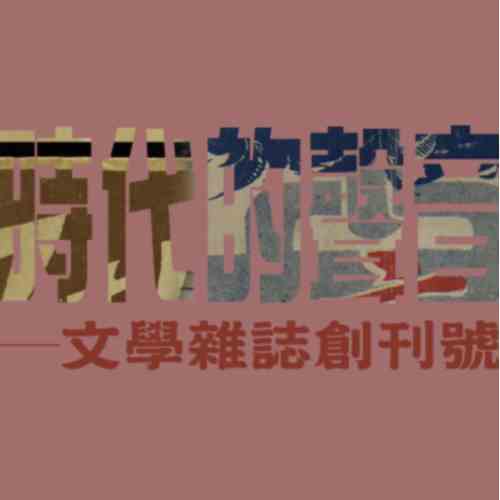Literary journals|Classical poetry journals|Civilian culture
The literary journals under the Japanese Colonial period represented a significant medium of literary communication in Taiwan, and they reflected the interaction between literature and society. Besides stimulating the development of the zeitgeist, they increased the close interaction among writers and then became the medium for releasing literary works and literary communities.
For example, Taiwan Literary Arts, one of the collections of the National Museum of Taiwan Literature, was founded in 1934 and became the official journal of the Taiwan Literature and Arts League. The authors of this journal were firstly from the Taichung region and then spread over the entire island, which promoted the New Literature movement enormously.
On the other side, Taiwanese Literature was later founded in 1941 because its founder, Zhang Wen-Huan, felt dissatisfied with the tendency of Literary Taiwan. The contents of this journal focused on literature with a tendency toward realism and the writing was presented with strong local style.
Literary journals
.jpg)
▸ The inaugural issue of Literary Taiwan (Donated by Huang De-Shi)
Pressed by Taiwan Literary Association, founded in January 1940, in Taipei.
In September 1929, Taiwanese Literary Association was established by Nishikawa Mitsuru. It consisted of a group of the professors from the Imperial University of Taipei, the officials of the Government-General of Taiwan, the Japanese poets in Taiwan, and a few Taiwanese writers. The members were recruited to maintain the operation of the journal. Nishikawa Mitsuru aimed to use this publication to “become the core of Taiwanese culture.” The journal contained fictions, poems, scripts, haiku, short songs, and paintings. Literary Taiwan ceased publication in January 1944, with the most longevity among the comprehensive literary journals issued in Taiwan during the Japanese Occupation period. Over the four years of publication, it could be divided into two periods, Taiwanese Literary Association and Literary Taiwan Society, due to the reorganization of the association. The styles of the two periods were different. In 1941, along with Taiwanese Literature, Literary Taiwan was listed as one of the top two purely literary journals in Taiwan in wartime. In 1943, Nishikawa Mitsuru claimed to dedicate Literary Taiwan to the Japanese Emperor when the “Literature Conference under the Decisive War in Taiwan” was held. In January 1944, the final issue was issued. Later it was merged into Taiwan Literary Arts with Taiwanese Literature, which was discontinued at the same time.
.jpg)
.jpg)
◆ ◆ ◆
.jpg)
▸ The inaugural issue of Taiwan New Literature (Donated by Huang De-Shi)
Starting publication by Taiwan New Literature Press in December 1935 in the form of a monthly, suspended on June 15, 1937, with a total of 15 issues pressed. The place of publication was Da-Tun County of Taichung Prefecture, namely Taichung City today.
Yang Kui, who left the Taiwan Literary and Arts League in November 1935, founded the Taiwan New Literature Press and released Taiwan New Literature. He pressed 15 issues, of which the 1st volume, 10th issue, was banned. Therefore, there are 14 issues left today. The editorial committee members, Lai He and Yang Shou-Yu, were responsible for the Chinese manuscripts. Wu Xin-Rong, Guo Shui-Ta and Wang Deng-Shan were responsible for Japanese poetry. Yang Kui, Lai Ming-Hong and Lai Qing were responsible for other Japanese manuscripts. Due to Yang Kui’s personal traits and ideal, the publication style reflected the poor public and presented the strong social and ethnological consciousness. The compiled contents such as “Maxim Gorky’s (Alexey Maksimovich Peshkov) Special” (Volume 1, Issue 8) and “Lament Lu Xun’s Death” (Volume 1, Issue 9), showed the admiration for the remarkable left-wing writers of the time.
.jpg)
.jpg)
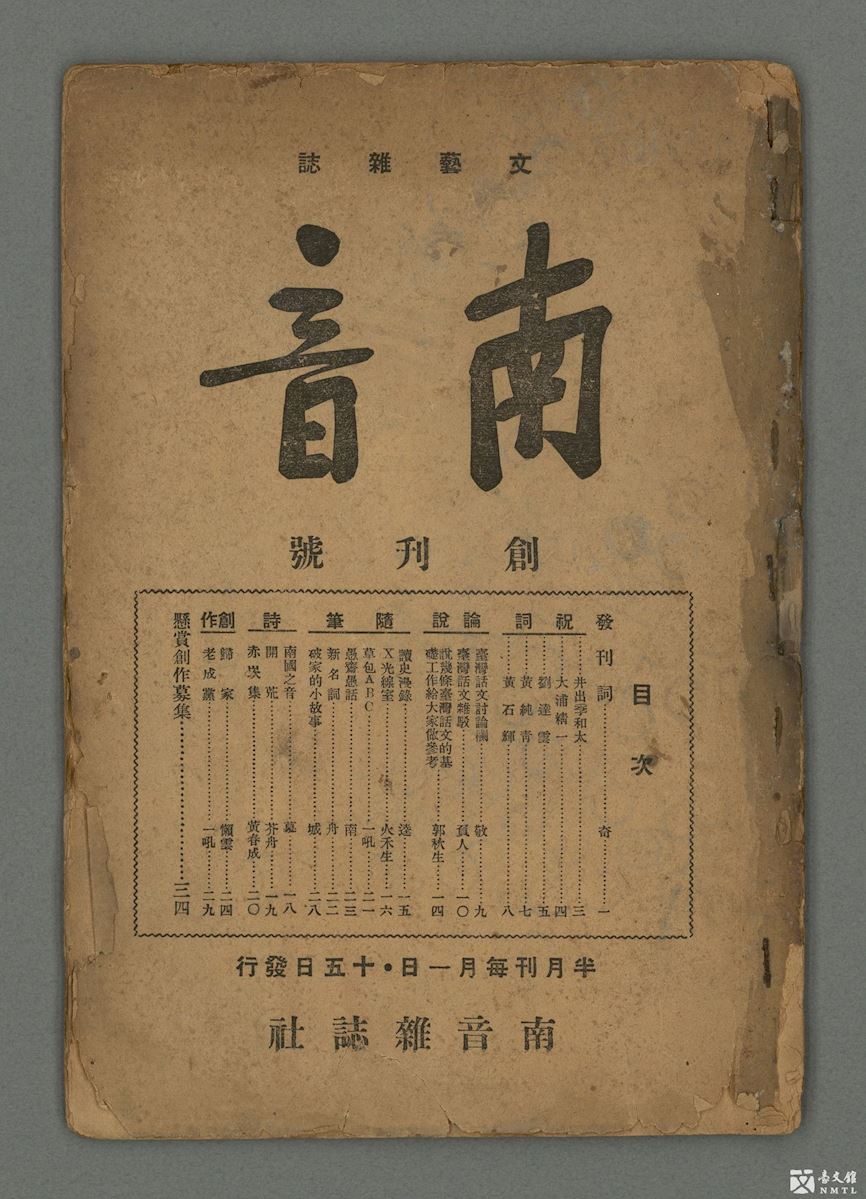
▸ The inaugural issue of Southern Voice (Donated by Long Yin-Zong)
Southern Voice was a Chinese semimonthly literary journal issued during the Japanese occupation of Taiwan by Southern Voice Press, which was established in autumn 1931 by Zhuang Sui-Xing (Chui Sheng), Ye Rong-Zhong, Guo Qiu-Sheng, and Huang Chun-Cheng. Following the call for contributions from 12 writers, including Lai He, Zhang Huan-Gui, Zhang Pin-San, Xu Wen-Kui, Zhou Ding-Shan, Hong You (Hong Yan-Qiu), Chen Feng-Yuan, and Wu Chun-Lin, the inaugural issue of Southern Voice was released in Taipei in January 1932, and its final issue was published in December that year. Inaugural editor Huang Chun-Cheng was later succeeded by Zhang Xing-Jian, from Taichung. According to Ye Rong-Zhong (Qi) in the foreword to the journal’s inaugural issue, the nonpartisan Southern Voice, “in the face of Taiwan’s political, economic, and social dilemmas,” was to be “an institution for exchanging ideology and knowledge” and to remain devoted to “literary enlightenment in addition to providing colleagues with a field for publishing.”
The inaugural issue contained essays and poems by Guo Qiu-Sheng and Huang Chun-Cheng (Nan) as well as fiction, including Lai He’s “Homecoming” and Zhou Ding-Shan’s (Yi Hou) “Old Party.” The issue also included a forum addressing the Taiwanese vernacular, which provided a platform for discussing the controversy of nativist literature and the Taiwanese vernacular that characterized Taiwan’s literary scene in the 1930s. Contents in the issue related to that topic comprised a column addressing the Taiwanese vernacular, Zhuang Sui-Xing’s (Fu Ren) “Words on the Taiwanese Vernacular,” and Guo Qiu-Sheng’s “On Some Basic Work of the Taiwanese Vernacular for Everyone.”
.jpg.jpg)
.jpg)
▸ The inaugural issue of Formosa (Donated by Huang De-Shi)
Edited by Su Wei-Xiong, published by Shi Xue-Xi, with the Taiwan Art Research Society in Tokyo, Japan in July 1933, in a total of 3 issues, irregular publication period, suspended in June 1934. The journal was founded by the Taiwanese international students who formed the Taiwan Art Research Society in Tokyo, Japan, including the editor-in-chief, Su Wei-Xiong, and other members such as Wang Bai-Yuan, Wu Kun-Huang, Wu Yong-Fu. Its works were diverse in style, including the focus on nativist literature and socialist trends. In the foreword of the inaugural issue, one of the members declared, “In addition to both the politically and economically free life that we desire, history requires artistic life. We will revive the sluggish Taiwanese literature and arts, and organize the existing weak literary works in action, as well as songs and legends. We appeal to the young Taiwanese to create pure literature of Taiwan with our full dedication.”
.jpg)
.jpg)
.jpg)
◆ ◆ ◆
.jpg)
▸ The inaugural issue of Taiwan Literary Arts (Donated by Zhao Tian-Yi)
Edited by Hiroshi Nagasaki, published by the Taiwan Literature League, Japanese Monthly, Volume 1, No. 1, published on May 1, 1944, 110 pages.
Taiwan Literary Arts was a publication of the Taiwan Literature League. It was written in Japanese, and it was basically combination of two Japanese literary magazines, Literary Taiwan and Taiwanese Literature. There were six members in the editorial committee, in addition to Zhang Wen-Huan as Taiwanese, the other five were Yano Hōjin, Koyama Saito, Takemura Takeshi, Hiroshi Nagasaki, and Nishikawa Mitsuru as Japanese. Yano Hōjin was not only the main person in charge of Taiwan Literary Arts, but also served as executive director of the Taiwan Literature and Arts League. In the foreword of the publication, he stated, “The future of this journal depends on the writers who live on the island. As long as they are passionate about contributing to the country by literature, they must consciously have the mission of guiding the public through article writing.” Moreover, Nishikawa Mitsuru said, “Our comrades are in all sincerity to literature, and aim to establish imperishable literature for the country”. It is not difficult to see the strong official nature of the journal from the two paragraphs and the relationship with the Japanese imperial system. In the inaugural issue, there were several well-known works by Taiwanese and Japanese writers, including Lu He-Ruo’s “Mountains and Trees,” Hamada Hayao’s “Start,” Nishikawa Mitsuru’s “Taiwanese Railways,” “Start” and “Taiwanese Railways.” “Taiwanese Railways” was originally serialized in Literary Taiwan, which was not finished due to the suspension of the journal, was re-published in Taiwan Literary Arts. Therefore, Taiwan Literary Arts was regarded as the successor of Literary Taiwan. On the back cover, there were advertisements of Taiwan Literature Series, such as Lu He-Ruo’s “Autumn” and Sakaguchi Reiko’s “The Zheng’s Family.” In general, Taiwan Literary Arts was a product of the war mobilization system. It mainly tends to romantic lyrics and nostalgic styles. In order to promote the “Colonization Literature,” writers were often required to write works that echo the national policy, inevitably under considerable restrictions. The journal was suspended in January 1945 for a total of 8 issues.
.jpg)
.jpg)
◆ ◆ ◆
.jpg)
▸ The inaugural issue of Beautiful Island (Donated by Long Yin-Zong)
Published during World War II and, more broadly, amid the Japanese occupation of Taiwan, the sole issue of Beautiful Island was released on December 1, 1939. The journal was the official publication of the Taiwan Poets Association, whose members included Nishikawa Mitsuru, and largely contained poems and a few prose works written in Japanese. An impressive 63 authors contributed to the issue, including Taiwanese writers Yang Yun-Ping, Huang De-Shi, Guo Shui-Tan, Wang Yu-Lin, and Long Yin-Zong and Japanese writers Nishikawa Mitsuru, Nakayama Susumu, Toshio Ikeda, and Honda Harumitsu. A painting by Tateishi Tetsuomi illuminated its pages as well.
Journal founder Nishikawa Mitsuru (1908–1999), who settled in Taiwan with his parents when he was three years old, began working at the New Taiwan Daily in April 1934, in which role he was in charge of the paper’s literary page and responsible for an affiliated journal, The Bibliophile. In September of that year, shortly after its establishment, the Mazu Study (later changed to Nikko Sanbou) published the journal Mazu, which Nishikawa edited, as he would do for all of the study’s publications. He not only designed the exquisite patterns of the publications—most were hand-bound, and all were limited in number—but also paid great attention to the paper quality. Five years later, in February 1939, the journal Taiwan’s Wind and Earth was released, and that September, the newly founded Taiwan Poets Association, under Nishikawa’s guidance, published Beautiful Island in December. In January 1940, once the Taiwan Poets Association was reorganized as the Taiwan Literary Artists Association, Nishikawa also supervised the release of the journal Literary Taiwan. In 1943, Nishikawa received the Taiwanese Culture Award from the Government-General of Taiwan for his masterpiece, Chi Qian Ji. A bookmaker above all, Nishikawa never ceased pursuing the beauty of books in the history of publishing in Taiwan, and his works have been cherished by both domestic and foreign bibliophiles.
.jpg)
.jpg)
◆ ◆ ◆
.jpg)
▸ The inaugural issue of Taiwanese Literature (Donated by Long Yin-Zong)
Released during the Japanese occupation of Taiwan, specifically from May 27, 1941, to December 1943, Taiwan Literature was a journal of new literature in Taiwan published by Qi Wen Press, chiefly by Zhang Wen-Huan and colleagues of the publishing house. In four issues per year, the journal contained creative work by young Taiwanese and Japanese writers, including Zhang Wen-Huan, Lu He-Ruo, Huang De-Shi, Wu Xin-Rong, Yang Kui, Wu Tian-Shang, and Zhang Dong-Fang. Along with Literary Taiwan, Taiwan Literature was one of the few literary publications compiled in Taiwan during the war. It was established to combat the Kominka movement as well as to facilitate the spread of work by Taiwanese writers, including Lu He-Ruo’s “The Rich Man’s Life,” Zhang Wen-Huan’s “Geisha’s House,” and Yang Kui’s “A Village Without Medicine.” Such works capture Taiwanese experiences during wartime, and given the oppressive atmosphere of the time, Taiwanese Literature became a crucial means of preserving the roots of literature in Taiwan.
.jpg)
.jpg)
◆ ◆ ◆
.jpg)
▸ The inaugural issue of Taiwan Arts (Donated by Ye Bing-Hui’s family)
Starting publication by Huang Zong-Kui on March 4, 1940, ceasing publication in November 1944, ink wash calligraphy by Lan Yin-Ding presented on the cover, in a total of about 50 pages.
Taiwan Arts was a journal with a large circulation during the Japanese Occupation period, and it had a record of up to 40,000 copies sold per month. The journal style was related to the personality of the editor-in-chief. After Jiang Xiao-Mei took over the position of the editor-in-chief from Huang Zong-Kui, he adopted a wide range of cultural routes, in addition to literature and art, the topics of politics, economy and affairs of the time were presented. The main authors of the journal were Jiang Xiao-Mei, Zhang Wen-Huan, Lu He-Ruo, Long Ying-Zong, Yang Kui, Wang Chang-Xiong, and Wu Zhuo-Liu. In addition to the column featuring Chinese poems, most of the works were published in Japanese. The special issue, namely The inaugural issue of Taiwan Arts, was mainly based on literature, including Zhang Wen-Huan’s review “The Future of Taiwanese literature,” Long Yuzong's fiction “The Morning”, and Ye Buyue's fiction, “Wedding Anniversary."
.jpg)
.jpg)
◆ ◆ ◆
.jpg)
▸ The inaugural issue of Taiwan Literary Arts (Donated by Huang De-Shi)
Published by The Taiwan Literature and Arts League in Taipei in November 1934, and suspended on August 28, 1936.
On May 6, 1934, Zhang Shen-Qie, Lai Ming-Hong and others established the Taiwan Literature and Arts League, and the official publication of the league was launched in November of the same year. The people involved in the league were not only writers but also artists and musicians. Together they formed an alliance. The paintings made by artists, such as Chen Cheng-Bo, Yan Shui-Long and Yang San-Lang, could be seen on the cover. The contents were divided into reviews, fictions, operas, poems, essays, and illustrations. It witnessed the impassioned interchanges between literature and arts. Moreover, the league gathered various fields and positions to promote the “popularization of literature and arts,”as well as to resist colonization. This was also the purpose of the publication of Taiwan Literary Arts, which was one of the literary journals founded by Taiwanese with the most writers presented and the longest-running status.
.jpg)
◆ ◆ ◆
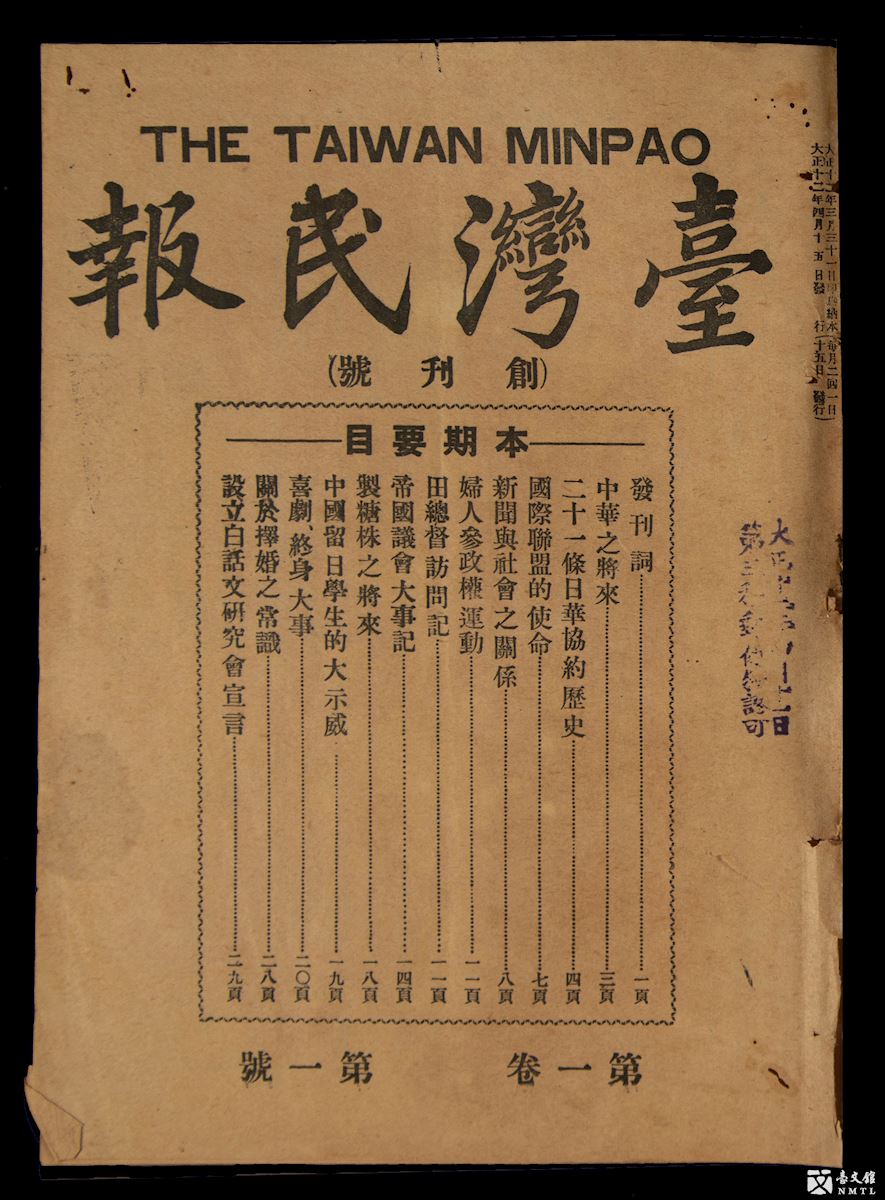
▸ The inaugural issue of Taiwan People’s Newspaper Bound edition: Issue 1- 50 (Donated by Liu Qing-Yun’s family)
The bound edition book was written with the name of Liu Qing-Yun on the back, which means that it was bound by Liu Qing-Yun. The collection contains the newspaper from Volume 1 to 3, Number 10 of Taiwan People’s Newspaper but was incomplete.
Taiwan People’s Newspaper was founded on April 15, 1923, and was suspended in June 1924. It began as a semi-monthly, published on the 1st and 15th every month. Later, it was changed to periodical appearing once every ten days, published on the 1st, 11th and 21st day every month. The editor was Lin Cheng-Lu, with the publisher Huang Cheng-Cong (Jian Ru). The contents contained social theories, reviews, internal and external affairs, miscellaneous records, academic essays, literature, and so on. Furthermore, the literary column contained fiction (including translations) and modern poetry.
Lin Cheng-Lu (1887-1967), pennaned Ci-Zhou, was from Taoyuan District, Taiwan. He graduated from the Department of National Language at the School of Government-General of Taiwan, and later the Department of Law at the Meiji University. Since 1918, he had been engaged in Taiwan's national movement in Tokyo, such as serving as a press officer of the Taiwan Youth journal and participating in campaigns relevant to the Taiwan Cultural Association and the petition for the foundation of Taiwan Parliament. He had served as the editor-in-chief in several media, such as Taiwan, Taiwan People’s Newspaper, Taiwan New People’s Newspaper and Xinnan News for 25 years, and he had contributed a lot to the news, publishing industry and the improvement of Taiwan's national consciousness.
.jpg)
◆ ◆ ◆
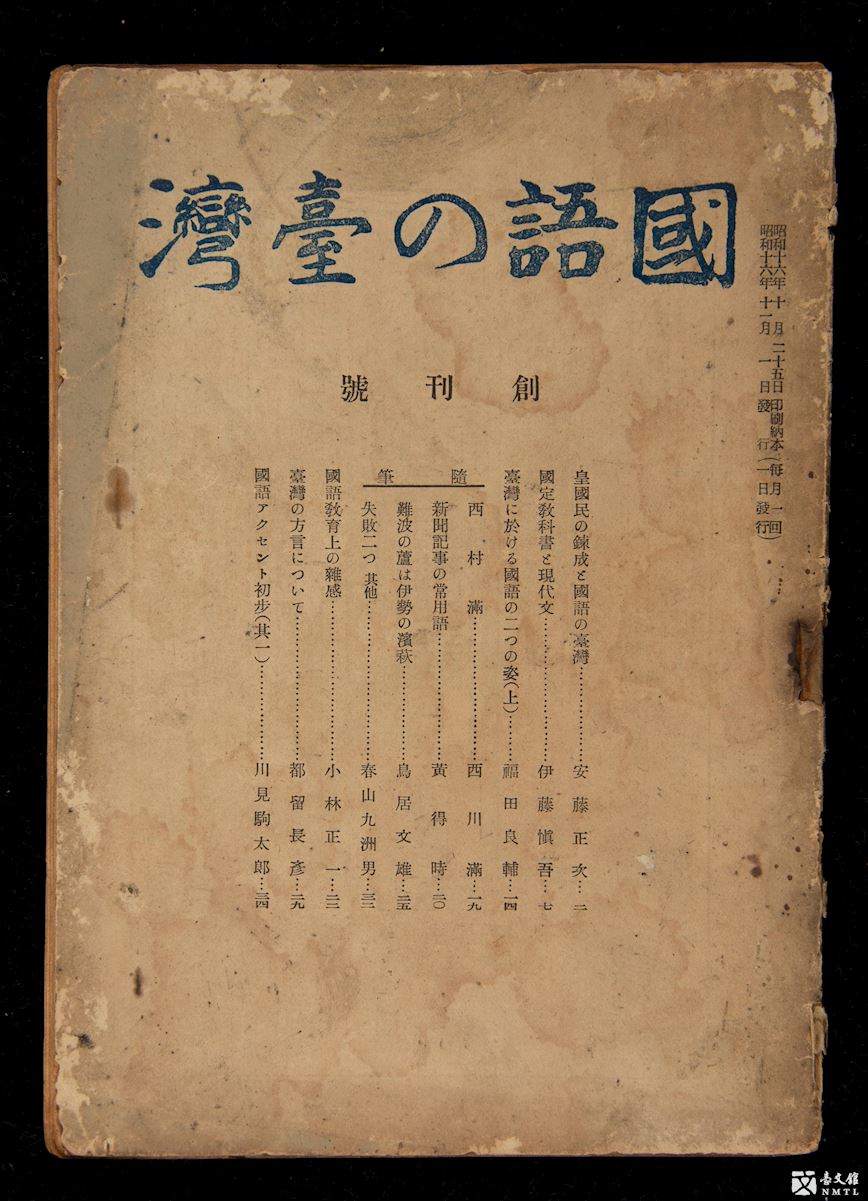
▸ The inaugural issue of National Language in Taiwan (Donated by Huang De-Shi)
The inaugural issue of National Language in Taiwan was pressed by National Language in Taiwan Press in Taipei in November of 1941.
From the title, it could be known that the purpose of this publication was to implement the Japanese language during the Japanese Occupation period. There was an increasing number of the writers who wrote in Japanese before the wartime in Taiwan. Different languages could still be freely used in some public fields at the time, although those, regarded as dialects, were opposed to colonial language, Japanese. The relevant discussion of this phenomenon was presented in the inaugural issue. Huang De-Shi, who was the only Taiwanese in this issue, published “The Common Words in Journalese” to discuss the journal publications of the time. Other publisher such as Andō Masatsugu, who was the first professor of the Department of Literary and Political Studies at the Imperial University of Taipei and then became the president of the University, his specialty was linguistics. He had deep research into the “national language.” The first issue of National language in Taiwan used Andō Masatsugu’s essay as the first work. It seemed to promote the national policy by the use of Andō Masatsugu’s reference. Another author, such as Kawasaki Ryotaro, was good at haiku and short songs. He explored the text of the creative works in the journal.
.jpg)
◆ ◆ ◆
.jpg)
▸ The inaugural issue of the New Youth reprinted bound edition (Volumn 1, No.1- No.6) (Donated by Huang De-Shi)
This journal was edited by Chen Du-Xiu and published by Yadong Library and Qiyi Bookstore in Shanghai, China. It was founded on September 15, 1915 and discontinued in July 1926. The inaugural issue was a bound edition of the re-publication.
In May 1919, the May Fourth New Culture Movement in China emerged. In September 1919, Chen Du-Xiu founded The Youth in Shanghai. In 1925, it was renamed New Youth, and ceased publication in July 1926. In the inaugural issue of the New Youth, Chen Du-Xiu wrote the article “To the Youth,” appealing to the youth to eliminate the old ideas and put forward six principles of youth’s action, independent rather than dependent, progressive rather than conservative, progressive rather than regressive, international rather than close, scientific rather than imaginary, and so on. In 1917, Chen Du-Xiu served as the dean of the School of Liberal Arts of Peking University. After that, Peking-based Hu Shi, Qian Xuan-Tong, Liu Ban-Nong, Lu Xun and Zhou Zuo-Ren became editors.
.jpg)
.jpg)
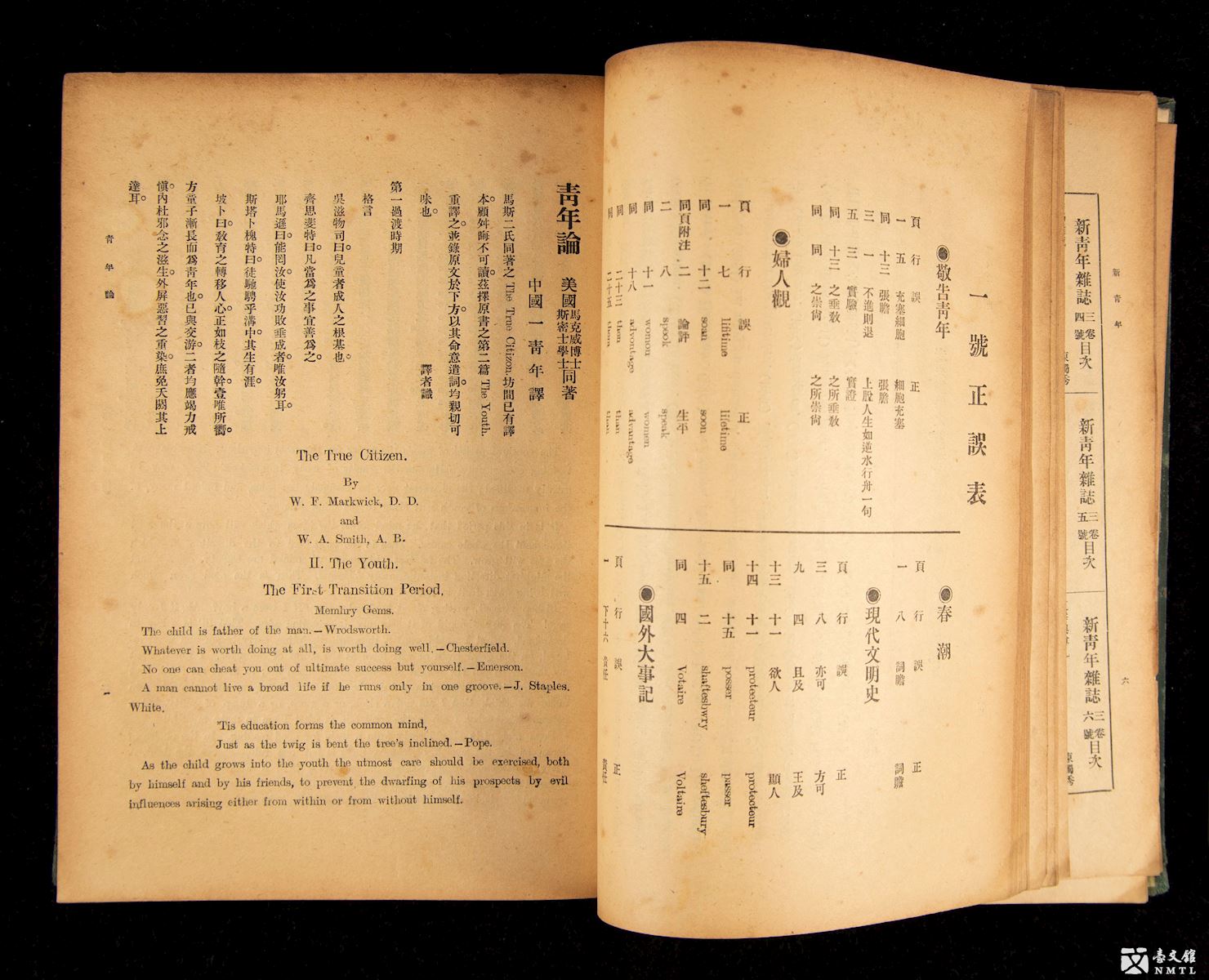
.jpg)
Classical poetry journals
.jpg)
▸ The inaugural issue of Taiwan Poetry: A Collection (Donated by Chen Yun-Cheng)
Taiwan Poetry: A Collection was a classic literature journal founded by Lian Ya-Tang in Taipei in February 1924. And it ceased publication in October 1925 in a total of 22 issues when Lian Ya-Tang recuperated in West Lake, Hangzhou, China. He pointed out the purpose of Taiwan Poetry: A Collection in the foreword, “Taiwanese poetics is flourishing today. However, the extension of the poetics needs to rely on the publication.” In other words, his motivation for establishing the journal was to maintain the tradition of the Taiwanese poetics and culture.
After Japan’s occupation in Taiwan, the tendency of the west culture led to the ruin of Sinology as well as moral principles. Taiwanese culture became gradually depressed. In order to revitalize traditional value, Lian Ya-Tang mentioned the two critical purposes of the publication of poetry in the 5th issue, “Yu Mo,” “to revitalize the modern literature and to preserve the books of the old times”. He adopted a compromising view, demonstrating that “the academics are still new, but the writing is still old.” Therefore, he published Taiwan Poetry: A Collection and covered the literary works of different eras, as well as the contemporary academic works.
.jpg)
.jpg)
.jpg)
Civilian culture
.jpg)
▸ The inaugural issue of Taiwan Folklore (Donated by Long Yin-Zong)
Released during World War II and thus during the Japanese occupation of Taiwan, the journal Taiwan Folklore was first published in October 1941 by Toto Books Corporation and ceased publication in January 1945. The journal addressed the everyday civilian culture of the Taiwanese people, including their customs, art, literature, songs, proverbs, religions, beliefs, cuisine, and medicine, in articles written by Taiwanese authors such as Yang Yun-Ping, Wu Xin-Rong, Yang Kui, Guo Shui-Tan, and Liao Han-Chen along with Japanese ones such as Kokubu Naoichi, Kanaseki Takeo, Toshio Ikeda, and Miyamoto Nobuhito. Because the journal expressly countered the Government-General of Taiwan’s Kominka policy (i.e., Japanization), its publication was suspended and even temporarily banned. Fortunately, publisher Kanaseki Takeo worked to negotiate the terms of the journal’s publication and ensured its continued issuance. A historical record of everyday Taiwanese life, Taiwan Folklore has become a critical part of Taiwan’s cultural heritage and was later reprinted by Wu Ling Press and Nan Tian Press; the latter edition is relatively complete. Taiwanese writer, Ye Shi-Tao, identified Taiwan Folklore as a journal that opposed the Kominka movement of the Government-General of Taiwan.
.jpg.jpg)
